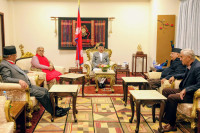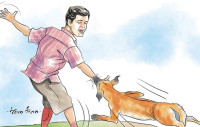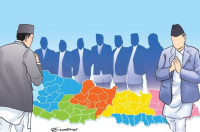Opinion
Rebuilding Kathmandu
Anthropologist Veena Das foregrounds the dual nature of everyday life through her work on the everyday practices of the urban poor in India.
Sabin Ninglekhu
Anthropologist Veena Das foregrounds the dual nature of everyday life through her work on the everyday practices of the urban poor in India. Das contends that the cure for myriad forms of injustice inherent in everyday life is to be found within everyday life itself. For clarity, another critical theorist, Henri Lefebvre, may be brought to bear on Das’ account of everyday life: “There is no thought without utopia, without an exploration of the possible, of the elsewhere; there is no thought without reference to practice.”
If utopia is to be broadly understood as the egalitarian pursuit of the good life, the ‘elsewhere’ that Lefebvre mentions may have a counterintuitive meaning—it is the practice of the here and now. Except, in planning visions, mostly circulated as Master Plan, a generic reference to any planning or rebuilding proposal, the location of these everyday practices is made to be elsewhere from the very Master Plan that is mandated with improving the conditions of the here and now. Instead, following Lefebvre, the ‘elsewhere’ may be explored—and found—in the here and now. In the aftermath of the 2015 earthquakes, different master plans have been put forward to rebuild different settlements in Kathmandu. Skimming through these templates, one realises that the ‘elsewhere’ appears to be conspicuously present precisely through its absence from the Master Plan.
Rumour as methodology
Based on a study investigating the government’s relief operation in the wake of the 2015 earthquakes, Yogesh Raj and Bhaskar Gautam of Martin Chautari, a social sciences research institute, have put forward ‘amnesia’ as an analytic device to evaluate relief. In wilfully forgetting long-documented archives of citizens’ information—voter ID, land ownership certificate and so forth—which could otherwise have been mobilised to map out relief, ‘amnesia’ reveals how the state, in the process, also absolves itself from delivering effective relief. In making their case, Raj and Gautam show how something as blurry as ‘amnesia’ may be deployed as a tangible tool to reveal the structural constraints that incapacitate the state.
Likewise, one may consider documenting something as free-floating as ‘rumour’ as a methodology to examine the discomforting ways rumour in and of itself becomes a reality that pushes a household or a community to make concrete reconstruction plans. A few ongoing real functions of rumours in the city: The head of a Gongabu family, who continue to live in a shack in a corner of their now-empty land, is currently working out a private loan deal just enough to fund the damp-proof course, the foundation, because its completion would make him eligible for a subsidised government loan. Because the engineering cost of Newar architecture is high, a Newar resident, instead, is considering rebuilding his house with only the façade subscribing to the Newar vernacular because doing so would exempt him from sacrificing a portion of his land for road expansion. A reconstruction committee has given up hope of rebuilding a heritage community under a community-prepared rebuilding proposal because “the National Reconstruction Authority (NRA) will not allow a single donor dollar for rebuilding other than the Rs300,000 from the government”.
These realities are taking shape in the face of a few uncomfortable truths: The NRA is not working on any provision for reconstruction-related subsidised household loan disbursal, period; a Newar façade will not exempt a house from the government’s eminent domain; one reconstruction committee is on the verge of abandoning the vision of heritage community even as another committee is realising a similar vision—aided by donor money and under the auspices of the NRA. It may be an exercise in futility to wonder why rumours emerge. They emerge to fill the gap left behind by ‘reliable information’, one of the casualties of crisis, as a former geography professor Pitambar Sharma once noted. But what is perhaps not futile is to critically document the ways in which rumours morph into action-inducing realities potentially leading to nowhere.
World of politics and dreams
During a recent event at Martin Chautari, a representative from the Urban Housing and Heritage Conservation Division (UHHCD) of the much-maligned NRA presented a panoptic imagery of a Kathmandu yet to come. The panoptic appeared to long for the architectural aesthetics of Bandipur, the night-time view of Simla streets, and public squares of cities in the West, vis-à-vis ongoing challenges facing the NRA. The apparent romance inherent in the imagery nearly reminds one of Khagendra Sangraula, a well-known public intellectual, saying that politics sustains itself by selling impossible dreams. My point being: Planning is, and ought to be, political, albeit not in the same way that politics is political.
Since its formation, it has been clear that the NRA, and as such, its internal governance and the capacity to govern, is held hostage by the interregnum that our polity is—the old is dead but the new has not been born yet. This challenge notwithstanding, the UHHCD may benefit from being multiply located; not just in the field of romance, dressed in the cloak of the Heritage City, for example, but also equally in the field of politics—that contested field of competing interests that raise urgent questions about fairness and equity. This field of politics begins to take shape when the romance, in being realised through implementing the Master Plan, encounters everyday life as it is actually lived—in different settlements and within households.
It is true that different settlements have different needs, and hence, require different levels of assistance. But the cleavage of difference runs deeper. Different households within a settlement have different needs, and that different ‘household heads’ are differently abled to convert whatever humanitarian assistance they receive in the name of ‘equality’ into outcomes that can genuinely aid their will to improve. And these differentials may manifest at the site of encounter, between utopian romance and ‘ordinary’ everyday life, in mundane yet explicit ways. Such an encounter may bring ‘equality’ in direct confrontation with ‘equity’, raising questions about who has the ‘legitimate’ right to speak about fairness, rights and justice, as they emerge. In this context, the stereotypical criticism of earthquake victims—“they spent the first instalment of government aid on food instead of building a house”—may need a rethink.
As such, it is in this everyday, elsewhere from the Master Plan, that a messy politics of rebuilding is actually unfolding in concrete terms. Very few appear to be waiting for ‘The City’ yet to come. Most have started rebuilding their homes through the sheer force of subversion, aided by rumour, among other tools, such as ‘hope’, and maybe ‘resilience’, that much-vaunted aphorism. In the face of these challenges facing the NRA, one of the next critical steps might be making sincere attempts to locate the unfolding ‘elsewhere’, that is the everyday, closer to the heart of its Master Plan.
Ninglekhu is conducting a long-term ethnographic research on the everyday politics of post-earthquake rebuilding in the Kathmandu Valley




 14.12°C Kathmandu
14.12°C Kathmandu










